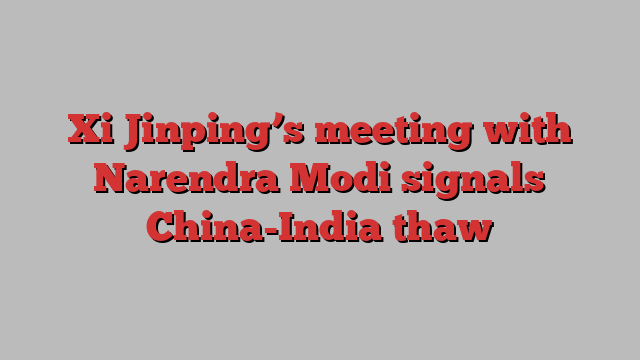
Unlock the Editor’s Digest for free
Roula Khalaf, Editor of the FT, selects her favourite stories in this weekly newsletter.
Xi Jinping and Narendra Modi, the Chinese and Indian leaders, have held their first formal bilateral meeting in five years, marking an apparent thaw in relations between the neighbouring nuclear-armed states.
The meeting, at the leaders’ summit of Brics nations in Kazan, Russia, on Wednesday, came days after the two countries announced an agreement on patrols along their disputed border, the site of deadly clashes four years ago.
The Chinese president used his meeting with India’s prime minister to urge co-operation between their nations as “two major developing countries and important members of the global south”, state news agency Xinhua reported.
China and India should “properly handle” differences and “set an example” for other developing countries to unite and promote “the multipolarisation of the world and the democratisation of international relations”, Xi said.
“The two leaders affirmed that stable, predictable and amicable bilateral relations between India and China, as two neighbours and the two largest nations on earth, will have a positive impact on regional and global peace and prosperity,” India said in a communique.
The two countries this week said they had reached an agreement on patrolling arrangements along their almost 3,500km disputed border in the Himalayas, known as the Line of Actual Control.
Troops from both sides clashed in hand-to-hand fighting in and around the Galwan Valley in eastern Ladakh in 2020, leaving at least 24 dead and prompting the Modi government to impose strict limits on Chinese foreign direct investment.
Since then, both countries each sent more than 50,000 troops to the border and bolstered roads and other infrastructure in the area, with India saying it would not restore normal relations with China unless “peace and tranquillity” were restored along the LAC.
In its communique, India said special representatives would meet soon to “oversee the management of peace and tranquillity in border areas and to explore a fair, reasonable and mutually acceptable solution to the boundary question”.
Details have not been released of what the two sides agreed in their pact on patrols and some analysts in India have expressed doubt that it is a substantial breakthrough.
“I think it will be India’s major mistake if we feel that the India-China relationship will be back to where it was pre-Galwan just by having this agreement on patrolling,” said Namrata Hasija, a research fellow at the Centre for China Analysis and Strategy in New Delhi. “China is very good at optics.”
The two countries’ relations plumbed new lows last year when Xi abruptly announced he would not attend a G20 summit in New Delhi. Analysts in China said the snub was because India had held G20 side meetings in the run-up to the summit in the disputed region of Kashmir, which is also claimed by Pakistan, and in Arunachal Pradesh, an Indian state in the Himalayas that China claims as its own.
Despite the diplomatic chill, China has surpassed the US as India’s biggest source of imports, with a large deficit in Beijing’s favour. Some Modi government officials and advisers have favoured easing limits on foreign direct investment and visas for Chinese nationals, which business groups say are impeding India’s push to become a major “China plus one” manufacturing nation.
Lin Minwang, a professor at the Centre for South Asian Studies at Fudan University in Shanghai, said that during its development, China had run large trade deficits with advanced manufacturing economies such as Japan.
“If India wants to make much progress in manufacturing, they have to have strong trade with China because China provides low-cost intermediary and capital goods, which will reduce the burden for Indian industrialisation,” Lin said.
China’s emphasis on a “multipolar” world is seen by analysts as code for its agenda of eroding US global dominance and creating more room for its own emergence as a superpower.
Xi is keen to use groupings such as the Brics to promote his agenda of creating an alternative world order, even though it includes democracies such as India and Brazil that have better relations with Washington.